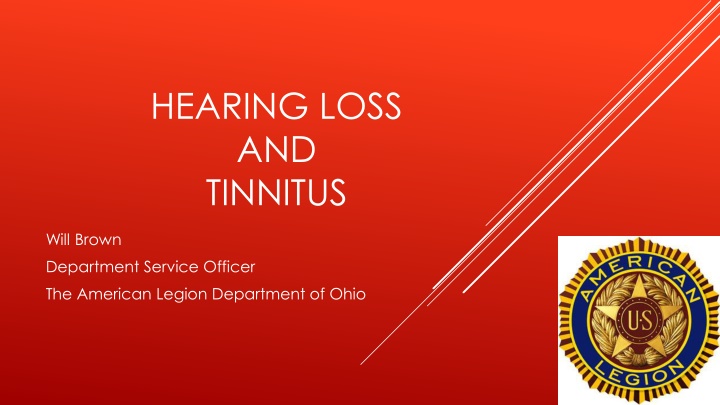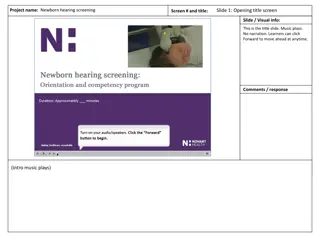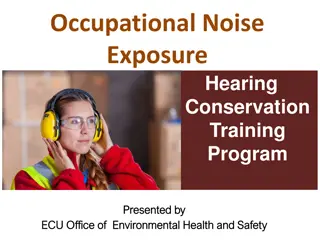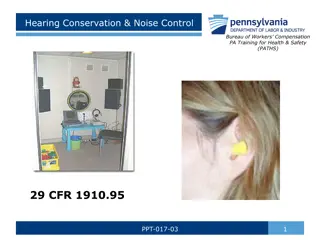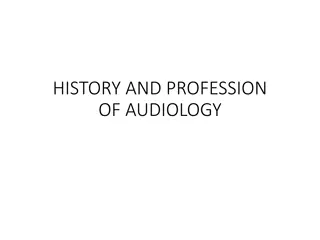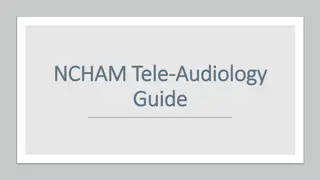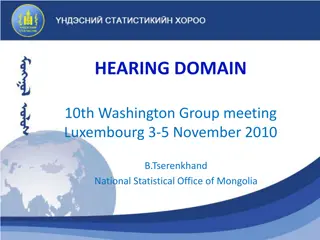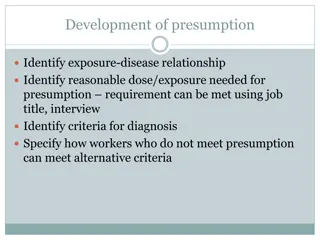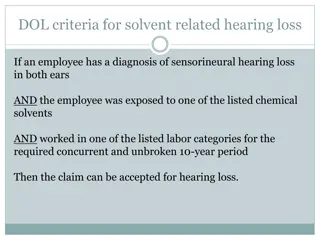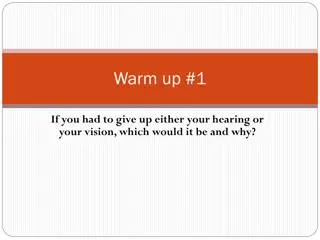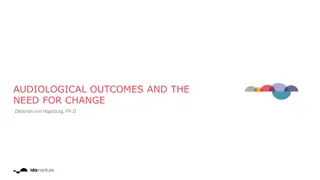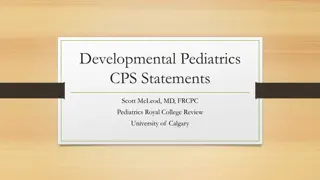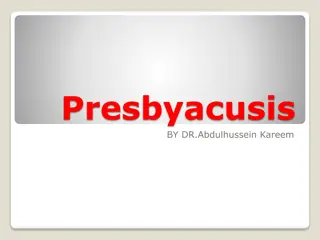Progressive Hearing Loss Case Study in North Wales Audiology Service
Congenital hearing loss case study from North Wales Audiology Service, detailing the patient's background, assessment, outcomes post-Cochlear Implantation (CI), and improvements in hearing abilities over time. Witness the journey of a 35-year-old individual with a history of bilateral hearing loss and how CI transformed their communication experience
Download Presentation

Please find below an Image/Link to download the presentation.
The content on the website is provided AS IS for your information and personal use only. It may not be sold, licensed, or shared on other websites without obtaining consent from the author.If you encounter any issues during the download, it is possible that the publisher has removed the file from their server.
You are allowed to download the files provided on this website for personal or commercial use, subject to the condition that they are used lawfully. All files are the property of their respective owners.
The content on the website is provided AS IS for your information and personal use only. It may not be sold, licensed, or shared on other websites without obtaining consent from the author.
E N D
Presentation Transcript
HEARING LOSS AND TINNITUS Will Brown Department Service Officer The American Legion Department of Ohio
REQUIREMENTS FOR HEARING LOSS AND TINNITUS Identify the different types of hearing loss. Identify how VA measures hearing loss. Describe ways to establish service connection for hearing conditions.
HEARING DISABILITIES Hearing Loss and Tinnitus are the two most common service-connected disabilities amoung U.S. veterans. More than 1.1 million veterans are service- connected for a hearing disability.1 More than 1.7 million veterans are service- connected for tinnitus.1 1 VBA Annual Benefit Report for FY 2017
THE EAR The outer ear, ear canal, inner ear, and auditory nerve all function to let us hear. The source of the problem defines the type of hearing loss.
TYPES OF HEARING LOSS 1. Conductive: Occurs when sound does not move efficiently through outer or middle ear. Can be caused by impacted ear wax of fluid in the ear due to cold, allergies, or ear infection. 2. Sensorineural: Occurs as a result of damage to inner ear or auditory nerve. Can be caused by noise exposure, head trauma, and aging.
TYPES OF HEARING LOSS, CONT. 3. Mixed: Occurs where there is damage to both outer/middle ear systems and inner ear auditory nerve. 4. Central: Occurs when parts of the brain that interpret sounds are damaged
HEARING LOSS FOR VA PURPOSES VA considers sensorineural hearing loss to be an other organic disease of the nervous system for purposes of the chronic disease presumptions outlined in 38 C.F.R. 3.309(a).1 VA uses pure-tone audiometry to measure hearing sensitivity. Thresholds indicate the softest sound a Veteran can hear at least 50% of the time. Hearing sensitivity is plotted on an audiogram that shows intensity as a function of frequency.
HEARING LOSS FOR VA PURPOSES Three ways to show hearing loss: 1. If auditory thresholds in any of the frequencies 500, 1000, 2000, 3000, 4000 Hertz is 40 decibels or greater. 2. If auditory thresholds for at least 3 of those frequencies are 26 decibels or greater. 3. If speech discrimination scores using the Maryland CNC2 Test are less than 94%. 1 38 C.F.R. 3.385. 2 Consonant-vowel nucleus consonant.
SPEECH DISCRIMINATION A speech discrimination score represents how well a list of spoken words could be heard and repeated. Pursuant to VA regulation1, speech discrimination testing must be done using the Maryland CNC word list. 1See 38 C.F.R. 4.85, 4.87. CNC: consonant-vowel nucleus-consonant
SERVICE CONNECTION FOR HEARING LOSS Service connection for hearing loss requires in-service exposure to noise (acoustic trauma): Combat Defined as giving or receiving fire.1 Look for Combat Infantry Badge (CIB), Combat Action Ribbon (CAR), Purple Heart, etc. for evidence, or Noise exposure based on MOS Does not have to be related to combat. Lay testimony can provide evidence. 1 Sizemore v. Principi, 20 Vet.App. 264 (2004). Service Connection for Hearing Loss MOS: Military Occupational Specialty
SERVICE CONNECTION FOR HEARING LOSS, CONT. Most times VA will deny service connection for veterans that do not have a shift in hearing loss form their entrance to their exit exams. However! Other important factors is when was hearing loss first noticed and (FDS) frequency, duration, and severity.
CASUALLY RELATED? When advising a veteran regarding hearing loss: What was the Military Occupation? Where did service put them i.e. (flight line, combat deployment motor pool). Was hearing protection used or offered. What was their employment after service? As mentioned in a previous slide Combat Action Ribbon, Combat Infantry Badge concedes exposure to noise.
SERVICE CONNECTION FOR HEARING LOSS, CONT. If there is a current diagnosis of hearing loss disability and evidence of noise exposure in service, then the Veteran has met the low threshold to receive a nexus examination.1 Even without a current diagnosis lay statements observing hearing loss can be sufficient to satisfy the first element. 1 McLendon v. Nicholson, 20 Vet.App. 79 (2006)
TINNIUTS Tinnitus is the subjective perception of ringing, blowing, roaring, buzzing, hissing, humming, whistling, or sizzling in one or both ears without an external stimulus. Can be either constant or intermittent. Tinnitus can have a gradual onset, with several years passing before symptoms are noticeable.1 1 Byung In Han, et al., Tinnitus: Characteristics, Causes, Mechanisms, and Treatments, 5 J. CLINICAL NEUROLOGY 11, 11-19 (2009)
SERVICE CONNECTION FOR TINNITUS Service connection for tinnitus requires: Current disability: Purely subjective Credible lay statement of symptoms is sufficient to establish a current disability. In-service event: Combat--look for same information as with hearing loss Noise exposure--based on Military Occupational Specialty (MOS).
SERVICE CONNECTION TINNITUS, CONT. Nexus: Tinnitus is an organic disease of the central nervous system (chronic condition).1 Credible lay statements regarding the onset of tinnitus are usually enough to establish nexus to in-service noise exposure. 1 VBA Adjudication Manual M21-1, Part III, Subpart iv, 4.G.1.d and Fountain v. McDonald, 27 Vet.App. 258 (2015)
SERVICE CONNECTION TINNITUS, CONT. Notes that ringing in the ears is capable of lay observantion.1 Tinnitus is a chronic and organic disease of the nervous system, and the veteran may establish nexus with lay evidence with proof of continuity of symptomatology.2 1 Charles v. Principi, 16 vet.App.370, 374 (2002) 2 Fountain v. McDonald, 13-0540 (2015)
WHAT THE VA EXAMINER IS CLAIMING VA lately has been denying Tinnitus, with the flowing rationale provided by VA Examiners: Tinnitus so known to be consistent with hearing loss and/or standard threshold shifts which is indicative of noise injury. Fountain v. McDonald, 13-0540 (2015), tinnitus is a chronic and organic disease of the nervous system, and the veteran may establish nexus with lay evidence with proof of continuity of symptomatology. See VA Training Letter 10-028 at 5 (stating that [t]innitus can be triggered months or years after an underlying cause (such as hearing loss) occurs, and that delayed-onset tinnitus must be considered ). Remand is required for VA to provide a medical opinion that adequately considers the appellant s tinnitus, including a theory of delayed onset tinnitus.
